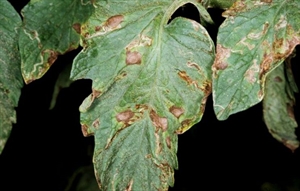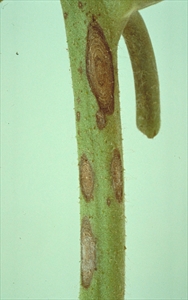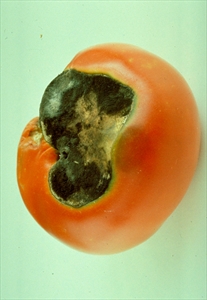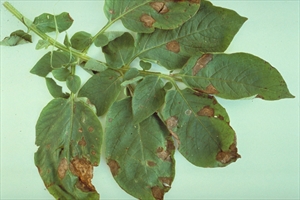Early blight of tomato and potato, target spot
Pacific Pests, Pathogens and Weeds - Online edition
Pacific Pests, Pathogens & Weeds
Tomato early blight (211)
Alternaria solani
Asia, Africa, North, South and Central America, the Caribbean, Europe, Oceania. It is recorded from Australia, Cook Islands, New Caledonia, Palau, Papua New Guinea, Solomon Islands, and Vanuatu.
Tomato, and many others in the same family, including potato, capsicum, eggplant, and some wild hosts in the tomato/potato (Solanum) family.
All parts of the plant, leaves, stems and fruit, are infected. Small, pinpoint to 6 mm, circular to angular brown spots occur on the older leaves, with yellow margins. As they grow, they develop dark brown rings, like a target, a characteristic of the disease (Photos 1&2, tomato & Photo 3, potato). The spots often merge, and the leaves dry up and fall. Loss of leaves can cause sunscald on the fruits.
On the stems, the spots are similar, except that they are darker and more elongated (Photo 4).
On the fruits, the spots are dark brown or black, sunken, extending over part or all of the fruit. The rots become covered in black spore masses of the fungus (Photo 5).
Spots also occur on the stems of seedlings as large brown spots near soil level, and may lead to stem break and death.
Spread over short distances occurs when spores are moved plant-to-plant in wind, rain and overhead irrigation water. Survival occurs in crop remains, and also on seed. Favourable conditions for the disease are warm, humid weather with heavy dews or rains.
Early blight of tomato is a serious disease requiring control measures, including fungicide applications. The disease occurs wherever tomato (and potato, Photos 6-8) is grown, and can cause severe defoliation, resulting in fewer, smaller fruit. Loss of yield is difficult to estimate, but probably at least 5%. Many millions of dollars are spent on fungicides to control the disease.
Look for the circular to angular brown spots on the leaves, checking to see if they have the characteristic target-like rings. Look to see more elongated spots on the stems. Look for fruits which produce dense black spore masses of the fungus.
CULTURAL CONTROL
Before planting:
- Make sure that the seed is free from contamination of the fungus, by saving seed only from disease-free plants.
- Remove any 'volunteer' tomato plants as well as weeds, especially those in the tomato family, from around nurseries, and in and around field plots.
- Carefully check each seedling before transplanting in the field, and remove any that show early blight symptoms. If symptoms are seen, discard the plant, and spray with fungicide.
- Select fields with good drainage, and where surrounding trees do not prevent airflow, so that leaves dry as rapidly as possible after rain or overhead irrigation.
During growth:
- Space plants (60-90 cm) so that air circulates around them; this helps to dry the leaves rapidly after overhead irrigation or rain.
- Remove a few branches from the lower part of the plants to allow better airflow at the base.
- Prune any diseased leaves from the bottom of the plants as they become infected.
- Preferably, water only at the base of the plant; avoid overhead irrigation or, if used, apply early in the day, to make sure the plants are dry before nightfall.
- Control weeds, as these may be sources of the fungus, especially those in the tomato/potato family.
- Make sure that the plants are healthy by applying fertilizer at recommended rates; healthy plants are less susceptible to this disease.
After harvest:
- Collect plant remains and burn them, or dig them deeply into the soil.
- Do not plant one crop of tomato after another in the same land; use a rotation of 2-3 years, avoiding crops that belong to the tomato family.
- Avoid planting overlapping crops of tomato, especially if outbreaks of early blight occur.
RESISTANT VARIETIES
Complete resistance does not exist, but there are varieties which show differences in tolerance to the disease.
CHEMICAL CONTROL
Use protectant fungicides, mancozeb, chlorothalonil or copper products. Systemic products are available, e.g., strobilurins, although they are expensive and, if used too often, the fungus may develop resistance to them.
____________________
When using a pesticide, always wear protective clothing and follow the instructions on the product label, such as dosage, timing of application, and pre-harvest interval. Recommendations will vary with the crop and system of cultivation. Expert advice on the most appropriate pesticide to use should always be sought from local agricultural authorities.
AUTHOR Grahame Jackson
Information from Diseases of vegetable crops in Australia(2010). Editors, Denis Persley, et al. CSIRO Publishing. Photos 1,4-6 Kohler F, et al. E (1997) Diseases of cultivated crops in Pacific Island countries. South Pacific Commission. Pirie Printers Pty Limited, Canberra, Australia. Photo 2 (taken by Eric McKenzie), and used in this fact sheet, appeared previously in McKenzie E (2013) Alternaria solani. PaDIL - (http://www.padil.gov.au). Photos 3,7&8 Jacquie (Wright) Kami, formerly Plant Pathologist, Secretariat of the Pacific Community.
Produced with support from the Australian Centre for International Agricultural Research under project PC/2010/090: Strengthening integrated crop management research in the Pacific Islands in support of sustainable intensification of high-value crop production, implemented by the University of Queensland and the Secretariat of the Pacific Community.











